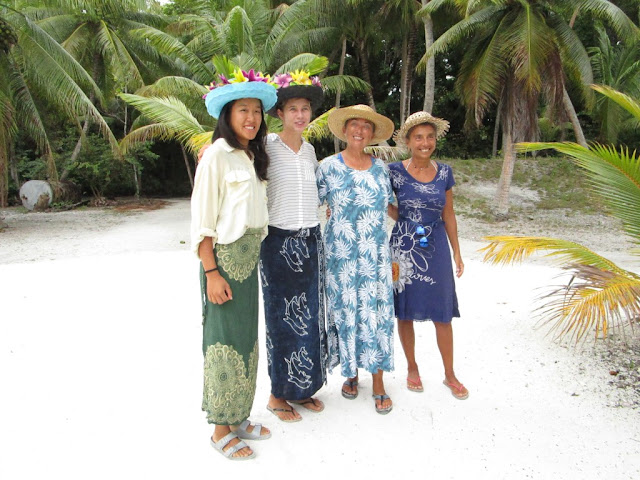 |
| Can you see the breakers in the distance? |
Beveridge Reef has a mysterious allure. It rises up directly from the sea floor, 16,000 ft below. It is hard to see (i.e., lies all underwater; there is no land) and wild (no people). Its location is ambiguously charted ("reported to lie 3 miles NE of shown position" - what?! Google Earth satellite imagery shows just a vague smudge). Cruisers often have to abandon their attempts to visit the awash atoll because the weather is frequently stormy here. It lies in the So. Pacific Convergence Zone (SPCZ) region which carries frequent overcast/windy/rainy/swell/nasty conditions. There are a couple of reported shipwreck remains here.
With hopeful anticipation and and a promising weather window, three of the boats that departed Palmerston decided to aim for a stop at Beveridge and to wait out a predicted 24 hr. windless period. CINNABAR, Y2K (with Italians Max and Alex), and FREYA (with Texan Lewis and South African Jules) all converged at Beveridge within hours of each other, in calm, sunny conditions. As we approached the general area, we gave our reported GPS waypoints a wide berth until we could actually see breakers in the distance. At about 4 nm away, the white breaking waves, the light blue under-clouds that reflected the shallow water in the reef, and a catamaran at anchor within, showed us exactly where Beveridge was. The catamaran assured us on the VHF radio that as we approached the reef, we would be able to see and readily negotiate the pass through the hidden reef.
After lining up on the pass (using the waypoints given in the above cruising website link) and with a big dose of faith, we increased engine power, monitored our instruments, maintained a keen watch of the sea ahead, and cautiously crept our way forward through the shoaling depths of entrance and finally into the sizable lagoon.
At one point, we became a little unnerved as it first appeared as if there was no gap at all in the waves breaking ahead. Where is the so-called pass? But then, as we got closer, we saw a gap of flat water in the near distance. The waves that initially appeared to be breaking across the pass were actually an optical illusion from the waves on the far distance shoreline, way across the opposite side of the lagoon. Whew - ok - got it.
After lining up on the pass (using the waypoints given in the above cruising website link) and with a big dose of faith, we increased engine power, monitored our instruments, maintained a keen watch of the sea ahead, and cautiously crept our way forward through the shoaling depths of entrance and finally into the sizable lagoon.
At one point, we became a little unnerved as it first appeared as if there was no gap at all in the waves breaking ahead. Where is the so-called pass? But then, as we got closer, we saw a gap of flat water in the near distance. The waves that initially appeared to be breaking across the pass were actually an optical illusion from the waves on the far distance shoreline, way across the opposite side of the lagoon. Whew - ok - got it.
 |
| Looking WNW from a drone's eye view, the pass is very obvious. Not so much when at sea level. (all drone pics are courtesy of Max on Y2K) |
Once inside it was flat and calm and blue, blue, blue. And silent. And full of a kind of mana (spirit). We idled around the inside periphery of this ocean 'lake', sounding the depths for a while, and spying one of the shipwrecks. We found that the entire lagoon has a depth of about 30-40 feet, and a sandy bottom with only scattered low coral heads, making for good anchoring. After selecting a spot on the SE corner, we dropped anchor and fully relaxed. It was noon time and a beautifully bright and sunny day. We first made a trip to the top of the mast to take some pictures, and then enjoyed an exploration snorkel in the severely clear water.
 |
| View of CINNABAR from the top of the mast. |
 |
| Y2K (closer) and CINNABAR (farther) from the drone, looking north. |
 |
| Y2K (closer boat) and FREYA anchored nearby. It is open ocean on the other side of the breakers. |
 |
| Sylvia Exploring. |
 |
| The fish were curious and unlike most places, not skittish. |
 |
| Checking the anchor set and the clear visibility. |
It was regretful that our visit was to be so short. Another day or two of snorkeling and exploring would have been optimal, but the sizable ocean groundswell kept it from being so. We would especially have liked to snorkel the area close to, but just south of, the pass. There is probably more abundant sea life action there.
 |
| Before the bouncy-rolly waves arrived. |
Exiting the atoll was very straightforward. The tide was near slack in the AM and we just followed our same arrival GPS track in reverse.
We are grateful to have experienced this unique, far away speck of ocean.
There is a pair of other similar mostly-submerged atolls on the route between Tonga and New Zealand. They are called the Minerva Reefs and are frequently used as a temporary shelter for boats transiting between the two countries. We may well stop there too in the near future if it helps with our passage to NZ.
Trip Totals:
Distance sailed = 293 nautical miles (Palmerston to Beveridge)
Avg speed = 6.3 kts.
Duration = 46.5 hrs.
Motored = 29.9 hrs. (some for battery charging, some because of light wind)























